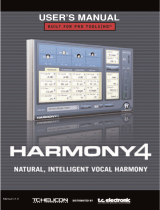1.
GLOBAL
GROUP
-
When activated, these three
effects stay on independent of preset changes. Press any
to activate or hold to enter a specific edit menu.
TONE
applies EQ, compression and more to improve the core
sound of your voice.
PITCH
adds subtle, chromatic pitch
correction to help you sing more in tune. Press
GUITAR
FX
to add modulation and reverb effects to the guitar
connected to the GUITAR IN jack. The GUITAR THRU
jack must be empty for GUITAR FX to be heard.
2.
HOME
-
Press this to return to the main performing
mode from SETUP, WIZARD, STORE or EDIT modes.
3.
MAIN
DISPLAY
-
All text and graphics feedback is
shown here.The Contrast adjustment is in the SYSTEM
tab of the SETUP menu.
4.
SETUP
-
Press this to access the I/O, MIDI, SYSTEM
and EXPRESSION pedal edit tabs.
5
.
WIZARD
-
This helps you find presets on the basis of
factory-assigned tags or to sort alphabetically by name.
6.
STORE
-
Press to enter a menu to name, assign a
destination and commit edited presets to memory. To
cancel and exit, press HOME.
7.
EDIT
-
Press to enter EDIT menu and make changes
to the μMOD, DELAY etc effects parameters via their
tabbed menus. HOME exits EDIT mode.
8.
MIX
/
EDIT
-
When HOME is lit, turning any of these
will temporarily present the MIX screen allowing control
of the relative levels of the VOICES (harmony and
doubling), DELAY/REVERB, GUITAR and OUTPUT level.
In EDIT mode, these controls adjust the highlighted
parameters immediately above them.
9. NAVIGATE CONTROLS - The Data Wheel scrolls
through presets when HOME is lit or through editing
rows when EDIT is lit.The left and right arrow buttons
increment presets up and down respectively when
HOME is lit or through edit tabs when EDIT is lit.
10.
PRESET
UP/DOWN
-
The UP arrow advances
through presets and the DOWN arrow reverses.
Holding either will accelerate in its direction.
Front Panel
10





















